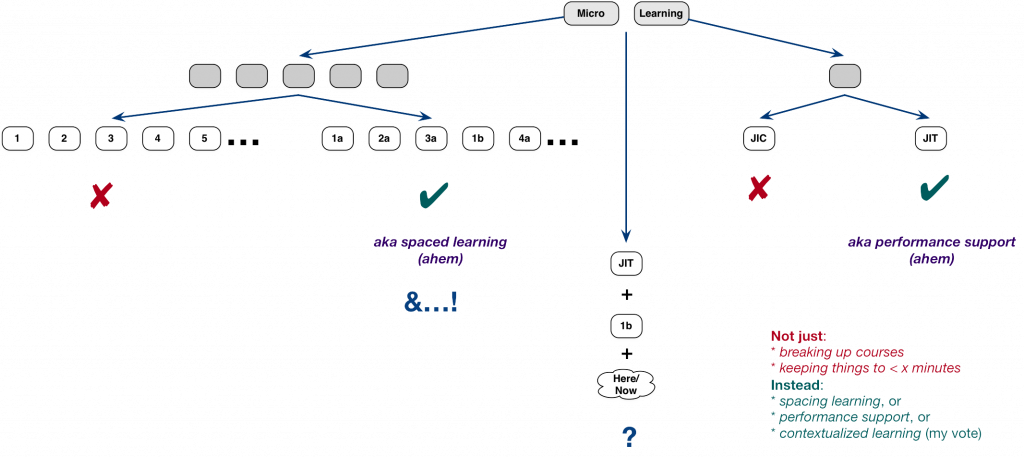I’ll be giving an upcoming webinar where I make my case for defining microlearning. And, as part of my usual wrestling with clarity, I created a diagram. I thought I’d share it with you.
What, you want me to walk you through it? :)
Microlearning is a portmanteau (technical term: mashup) of micro and learning. Thus, it implies small bits of learning. Here I’m mapping it out in several ways. I’ve previously argued that there are three main ways, but let’s map the first two out. It’s either
- a series of objects contributing to a learning experience
- a one-off object that creates learning
And there are problems with both. Too often, folks talk about breaking an existing course down into small chunks, and I suggest that won’t work without some significant (!) effort. Just breaking it up means something seen earlier can be forgotten, so you need to worry about knowledge atrophy and plan reactivation. And that’s just spaced learning!
And I think it’s unlikely that you can have a single object lead to any meaningful learning. However, such an object can serve as support to succeed in the moment. How-to videos, job aids, and the like all can be used to achieve an outcome. And that’s just performance support!
What I think is the real untapped opportunity that could (and I say should) capture the moniker would be contextualized learning. Layering on a bit of learning because of when and where you are that develops you over time. It’s combining the two, potentially, so you help someone in the moment but add in the bit that also makes it a learning experience. There’s much more to this, but that’s the core idea.
My main issue here is that people are fast and loose with the term microlearning, and I’d like to make sure people are either talking about spaced learning or performance support (both good). And not talking about just breaking up a course into chunks that are nice to consume but not engineered to lead to retention and transfer (not so good). Of course, better yet if we converge on contextualized learning!

Nice article Mr.Quinn! I’ve been waiting for someone to articulate a “taxonomy for Microlearning. “ Do you think it’s plausible to break lower-order content (facts, concepts, and procedures) as part of a course and deliver via Microlearning, assuming it’s concrete and granular? Perhaps the LMS’ logic could handle spacing so as to reduce the likelihood of a learner forgetting?
BTW, I attended three Microlearning breakout sessions at DevLearn 17, and none of the presenters could describe what they perceive as the difference between performance support and Microlearning. Interesting… considering so many people are evangelizing Microlearning as the future of learning and performance improvement.
Nice. My only add would be that sometimes the job itself provides enough reinforcement/spaced learning that a single event (micro-event) might be all that was needed.
I worked as a part-time inside salesperson at a lumber yard while in college in the late 1970s – and after I asked Al (the old guy) that first morning what the code number was for plywood (406) in the Product Code/Price book that was over 3 inches thick – I had sold enough plywood throughout that first day and the next – that 406 was burned indelibly into my memory. That “20” with Al was only needed once. Now I did pester him with the code number for almost everything else for the first few weeks – but I was good to go for finding the right plywood after that micro-20-event.
Thank you for your continued contributions!
Curtis, thanks for the kind words. I do think LMSs could be built to handle the spacing. And while I prefer a simpler breakdown of ‘knowledge you need and the complex skills that use that knowledge to solve problems’, microlearning could be used to develop the knowledge. But I think it can also be used to develop the skills (e.g small problems where the alternatives to the right answer get increasingly nuanced and require applying the knowledge to make decisions. At least to reactivate. I have greater trouble thinking of microlearning handle complex work products, but willing to be wrong. Similarly, where it gets complex I have trouble seeing how to integrate social knowledge negotiation (a powerful tool in our instructional repertoire). Finally, I fully agree that the lack of willingness for conceptual clarity is a glaring indictment of our field.
Guy, thanks. I do believe (and mentioned in the webinar) that there can be those serendipitous moments, but my problem is that I think they’re rare and hard to identify. Still, they can exist and even can be created. It’s just that it’s a small subset of what microlearning is being touted for, and not where we need to direct our best thinking. And thanks for your continued contributions too.
Made a video of it here: https://youtu.be/4MwTa0bHdrc